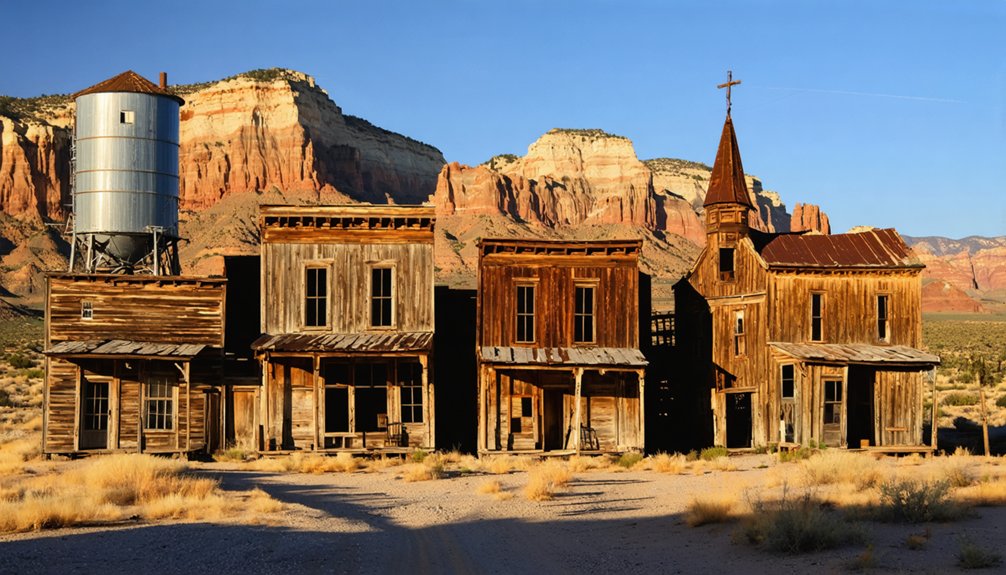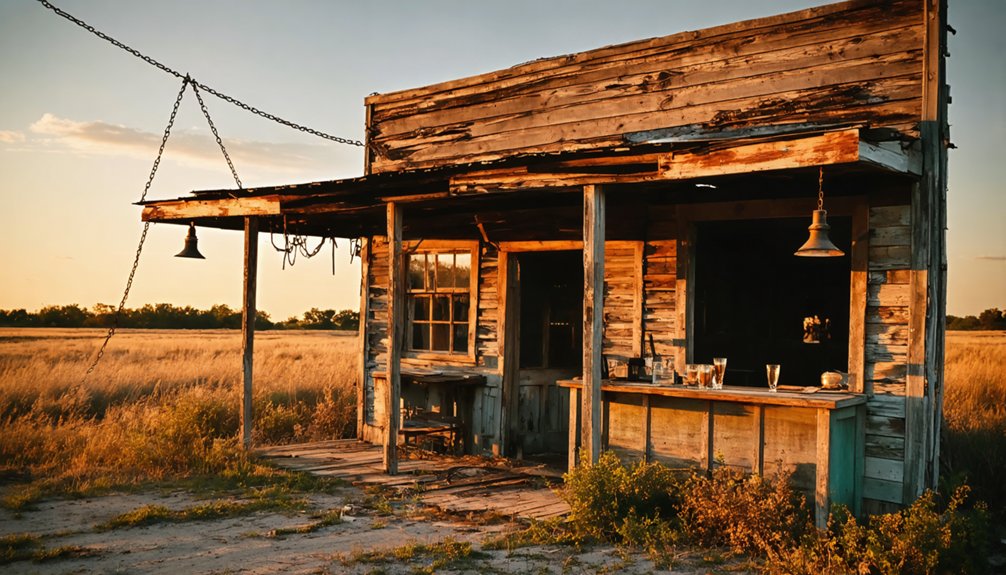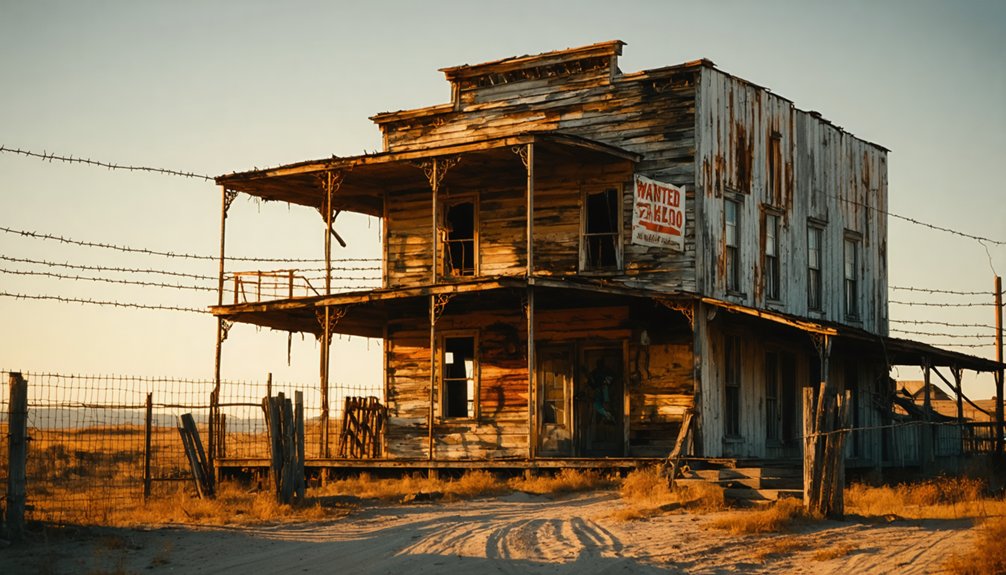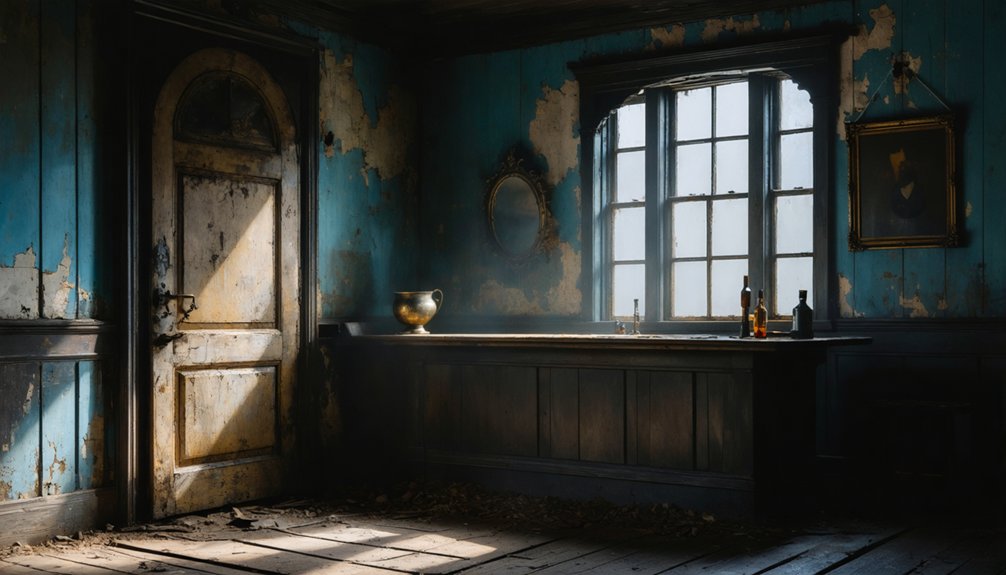Utah’s most haunting ghost towns include Grafton with its movie-famous buildings, Silver Reef where silver was impossibly found in sandstone, Old Irontown’s 150-year-old beehive kilns, wild Frisco with its lawless past, Thistle’s half-submerged remains from America’s costliest landslide, Silver City’s mining ruins, and Modena’s railroad heritage marked by a solitary stone schoolhouse. Each abandoned settlement offers a window into Utah’s pioneer resilience and industrial ambitions.
Key Takeaways
- Grafton features five historic Mormon pioneer structures, including an 1886 schoolhouse, and served as a filming location for “Butch Cassidy and the Sundance Kid.”
- Silver Reef produced $25 million in silver ore and features ghostly whispers and unmarked graves in its Pioneer Cemetery.
- Old Irontown showcases a 150-year-old beehive kiln with original soot and holds the distinction as Utah’s first ghost town.
- Frisco’s beehive-shaped charcoal kilns and abandoned structures remain from its lawless boomtown era when 6,000 residents sought silver fortune.
- Thistle’s partially submerged red schoolhouse stands as an eerie monument to America’s costliest landslide, which buried the town in 1983.
Grafton: The Silent Movie Set By The Virgin River
Whispers of frontier ambition echo through the cottonwood-lined paths of Grafton, a meticulously preserved ghost town nestled along the Virgin River’s banks in southwestern Utah.
You’ll walk where Mormon pioneers settled in 1859, their cotton mission dreams eventually undone by relentless floods and harsh frontier realities.
By 1866, Grafton had grown to 168 residents before environmental challenges and the Hurricane Canal’s construction led to its abandonment by 1906.
The town’s five remaining structures—including the 1886 schoolhouse and three pioneer homes—stand as silent sentinels to this frontier chapter.
The historic Grafton Cemetery contains numerous graves with dates from 1860, offering visitors a poignant glimpse into the challenges faced by these early settlers.
Visitors should be aware that Grafton is partially privately owned and respect all property boundaries during their exploration.
Grafton’s film legacy extends from early cinema with “In Old Arizona” (1928) to the iconic bicycle scene in “Butch Cassidy and the Sundance Kid” (1969), cementing its status as the West’s most photographed ghost town.
Silver Reef: Southern Utah’s Silver Boomtown Frozen In Time
While Grafton tells tales of failed cotton missions, fifty miles to the northwest stands Silver Reef—a geological marvel where the impossible became possible.
Where forgotten dreams lie dormant, unexpected wonders await those willing to see beyond failure.
When experts claimed silver couldn’t exist in sandstone, Walker Brothers bankers backed prospectors anyway, launching an unprecedented boomtown that swelled to 2,000 residents by 1879.
You’ll walk streets where $25 million in silver ore once flowed from sandstone reefs, powering saloons, a racetrack, and a vibrant Chinatown. The discovery was made when John Kemple found silver in sandstone while seeking shelter near Leeds in 1866. The town gained notoriety for its frontier justice as shootouts became a common occurrence at establishments like The Cosmopolitan Saloon.
The 1879 fire, plummeting silver prices, and flooded mines eventually silenced the town by 1891, though mining history lingers in crumbling foundations and the preserved Silver Reef Museum.
Listen carefully—ghostly whispers in English and Chinese still echo through abandoned mine shafts, while unmarked graves in Pioneer Cemetery hold hundreds of forgotten souls from this brief, brilliant flash of prosperity.
Old Irontown: Where Beehive Ovens Still Stand Tall
The skeletal remains of Old Irontown stand as evidence to Utah’s brief but ambitious industrial era, where the state’s second major iron mining operation was established in 1868 just 24 miles west of Cedar City.
At its height, 19 families called this company town home, with a complete infrastructure supporting the extraction of ore from nearby Iron Mountain. Despite its harsh desert conditions, the settlement persisted for nearly a decade. The settlement’s most distinctive feature—a preserved beehive kiln where workers created charcoal for iron smelting—still displays 150-year-old soot inside its dome.
Economic forces, including the Panic of 1873 and cheaper eastern iron shipped by rail, forced production to cease by 1876.
By the 1880s, the town stood abandoned, becoming Utah’s first ghost town.
Today, you’ll find the ruins preserved on the National Register of Historic Places, freely accessible for exploration. Visitors can still see the remaining kiln, furnace, and foundry that once formed the heart of this mining community.
Frisco: Remains Of The Wild Western Frontier
Far from the quiet soot-covered kilns of Old Irontown, Frisco exploded onto Utah’s landscape in 1875 when prospectors struck silver in the San Francisco Mountains.
By 1880, this boomtown housed 6,000 souls and earned the title “wildest town in the Great Basin.” Frisco’s lawlessness was legendary—murders occurred so frequently that a daily wagon collected bodies for the boot hill cemetery. The town had 23 saloons and numerous brothels, contributing to its notorious reputation.
The Horn Silver Mine yielded over $60 million in precious metals before disaster struck in 1885. A catastrophic cave-in collapsed tunnels to the seventh level, signaling the beginning of mining decline. The mine was considered one of the richest silver deposits discovered in the United States during that era.
Though operations continued on a smaller scale, Frisco never recovered its former glory.
Today, you’ll find beehive-shaped charcoal kilns, abandoned mine shafts, and dilapidated wooden structures—ghostly remnants of Utah’s most notorious frontier town.
Thistle: A Town Swallowed By Landslide And Flood
As you travel through the haunting remains of Thistle, you’ll witness the catastrophic aftermath of America’s costliest landslide, which in April 1983 buried this once-thriving railroad community under millions of cubic yards of earth and created an impromptu lake.
The still-visible red schoolhouse and partially submerged structures stand as eerie monuments to nature’s destructive power, transformed from bustling transportation hub to underwater ghost town in mere weeks. The evacuation forced residents to leave with only limited belongings, watching helplessly as water eventually reached their rooftops.
These modern ruins serve as a sobering environmental warning about the consequences of unprecedented precipitation and rapid snowmelt in Utah’s vulnerable mountain landscapes. During Thistle’s peak, the town supported a vibrant community of over 1,600 residents engaged in social activities like plays, dances, and concerts.
Railroad Disaster Epicenter
Once a thriving railroad junction nestled in the picturesque Spanish Fork Canyon, Thistle transformed from bustling community to underwater ghost town in the spring of 1983.
You’re looking at the epicenter of America’s costliest landslide disaster, where Thistle’s history was literally submerged overnight.
The catastrophe struck on April 16, when unprecedented rainfall triggered a massive earthflow that dammed the Spanish Fork River.
As waters rose, they swallowed the critical railroad junction where Denver & Rio Grande Western and Utah Railway converged.
The disaster buried miles of tracks that had defined Thistle’s existence since 1878.
Standing here today, you’re witnessing the aftermath of nature’s unstoppable force – a place where railroad economics had already diminished a once-vibrant town before water finished the job.
Modern Ruins Remain
Driving along U.S. Route 6/89, you’ll glimpse the haunting thistle ruins jutting from boggy waters—silent monuments to nature’s devastating power.
This ghost town’s remains tell a stark tale of destruction, with several structures still visible across the submerged landscape.
For the freedom-seeking explorer, Thistle offers these eerie remnants:
- Half-sunken house partially protruding from swampy terrain
- Red schoolhouse ruins crumbling against the mountainside
- Historical marker detailing the town’s sudden obliteration
- Foundations and scattered debris marking where families once lived
The million cubic yards of earth that slid in 1983 created a 3-mile lake up to 160 feet deep, entombing most of Thistle forever.
Today, these architectural skeletons stand as chronological markers of the moment time stopped for this once-thriving community.
Environmental Cautionary Tale
Beneath the placid waters of Thistle Lake lies a sobering environmental warning that resonates far beyond Utah’s borders. The 1983 disaster reveals how multiple natural factors—record precipitation, rapid snowmelt, and unstable geology—can converge with catastrophic consequences.
When you visit today, you’re witnessing the aftermath of America’s costliest landslide, a $200 million catastrophe that transformed a living community into an underwater ghost town. The slide’s continuing movement serves as a stark reminder of nature’s persistent power, with reactivations as recently as 1998 expanding the slide area considerably.
Modern landslide prevention efforts draw directly from Thistle’s lessons, emphasizing environmental awareness and geological monitoring in vulnerable areas.
This submerged town stands as nature’s permanent exhibit on the consequences of ignoring environmental warning signs in development decisions.
Silver City: From Mining Promise To Quiet Canyon Ruins

Tucked away at the mouth of Dragon Canyon in Utah’s East Tintic Mountains, Silver City emerged in 1869 when adventurous cowboy George Rust established the settlement following promising mineral discoveries nearby.
This mining legacy began with tents and a saloon before growing to 800 residents during its boom years.
You’ll find Silver City’s story marked by dramatic cycles of prosperity and decline:
- Reached 1,500 residents after Jesse Knight built the Tintic Smelter in 1907
- Suffered devastating fires in 1902 and later at Knight’s mill
- Struggled with flooded mines that eventually made operations unprofitable
- Connected to the world via three separate railroads during peak operations
Today, only foundations, smelter ruins, and a National Historic Register cemetery remain as quiet witnesses to this once-bustling canyon settlement.
Modena: The Desert Railroad Ghost Along The Nevada Border
You’ll find Modena’s railroad glory days preserved in the scattered stone structures near the Nevada border, where the 1898 Utah and Nevada Railway depot once bustled with up to 900 residents.
The town’s strategic location beside Desert Springs made it crucial for steam locomotives needing water, transforming this remote spot into a key shipping hub for merchants from St. George and Mesquite.
Though largely abandoned after diesel engines eliminated the need for frequent water stops, Modena’s weathered hotel and remaining buildings stand as silent sentinels to Iron County’s railroad heritage.
Railroad Boom Days
The whistle of steam locomotives once echoed across Modena’s desert landscape when the Utah and Nevada Railway established this essential railroad town in December 1899.
This strategic location near Desert Springs provided crucial water for steam engines, transforming Modena into a critical railroad hub of remarkable economic significance.
During its heyday, you’d have witnessed:
- Merchants from St. George and Mesquite arriving to collect rail-shipped goods
- A bustling population approaching 900 residents
- A two-room schoolhouse educating local children
- Multiple businesses thriving alongside railroad operations
The invention of diesel engines triggered Modena’s economic decline, eliminating the need for water stops.
Railroad workers relocated to Enterprise as opportunities dwindled, and the once-vibrant commercial center began its slow transformation into the living ghost town you’ll find today.
Remaining Stone Buildings
Just one magnificent stone structure remains standing in Modena’s windswept landscape—the former two-room schoolhouse that once educated 29 local children during the 1942-43 academic year.
This impressive example of stone preservation stands as a symbol of the practical architectural choices of frontier settlements, where builders selected materials that could withstand the harsh desert elements.
You’ll also spot the deteriorating Lund hotel nearby, its fire-damaged stone walls still displaying remarkable architectural significance despite decades of neglect.
The durability of these stone buildings explains their survival while wooden structures succumbed to time and weather.
When you explore Modena today, these stone remnants offer your clearest window into the town’s railroad glory days, standing in stark contrast to the weathered wooden cabins and rusty metal structures surrounding them.
Frequently Asked Questions
Are Any Utah Ghost Towns Legally Off-Limits to Visitors?
Yes, many Utah ghost towns on private property are legally off-limits. You’ll encounter strict ghost town regulations and visitor restrictions when properties display “no trespassing” signs or contain dangerous abandoned mines.
What Paranormal Activity Has Been Reported in These Abandoned Towns?
Like Poe’s midnight visitor, Utah’s ghost towns manifest spectral miners, ghostly lights, and disembodied voices. You’ll encounter ghost sightings around mine shafts, haunted history in old brothels, and unexplained audio phenomena throughout these abandoned settlements.
Can You Camp Overnight at Any Ghost Town Sites?
You can camp at ghost towns on public land unless posted otherwise. Follow BLM’s 14-day limit, respect camping regulations, maintain ghost town etiquette by avoiding historic structures, and always practice leave-no-trace principles.
Which Ghost Town Has the Best Preserved Original Artifacts?
Grafton offers you the best artifact preservation with its remarkably intact adobe schoolhouse and original structures. You’ll appreciate the historical significance of authentic architectural details untouched by modern development.
When Is the Best Season to Visit Utah’s Ghost Towns?
Early birds catch the worm in Utah’s ghost towns. You’ll experience the best time during spring (March-April) and fall (October), when seasonal weather remains mild and you’ll avoid summer crowds.
References
- https://www.valleyjournals.com/2024/10/02/507818/exploring-utah-s-ghost-towns-seven-abandoned-settlements-with-fascinating-histories
- https://pauldail.com/2014/11/07/ghost-hunt-southern-utah-paranormal/
- https://www.visitutah.com/things-to-do/history-culture/ghost-towns
- https://www.gothichorrorstories.com/real-ghost-stories/
- https://www.deseret.com/utah/2024/06/03/how-to-visit-utah-ghost-towns/
- https://stowawaymag.byu.edu/tag/ghosts
- https://www.youtube.com/watch?v=ON-iB3vXTQE
- https://www.utahvalley.com/plan/day-trips-itineraries/history-buff/ghost-towns-and-haunted-places/
- https://en.wikipedia.org/wiki/List_of_ghost_towns_in_Utah
- https://www.youtube.com/watch?v=qiAm7JlvZiw



